Planting and Handling Conifer Seedlings in New Mexico
Circular 526
Gregory A. Fancher, Superintendent, More Research Center
John G. Mexal, Professor, Department of Agronomy and Horticulture
James T. Fisher, Professor, Department of Agronomy and Horticulture
College of Agriculture, Consumer and Environmental Sciences New Mexico State University
As recent as 10 years ago, conifer plantings in New Mexico had only sporadic success, with generally low survival rates. Poor survival was blamed on seedling quality or drought. However, many failures were probably caused by improper seedling care or the actual planting technique. Planting methods should provide acceptable survival at minimum establishment costs, in terms of cost pers surviving tree. Close attention to the biological requirements of the planting stock and proven planting techniques will enhance survival and the long-term performance of newly planted seedlings. Survival rates of 80 to 90% are possible with proper site preparation, handling practices and planting techniques. This circular describes proper site preparation and planting techniques for bareroot and containerized conifer seedlings.
Species
Many factors must be considered when choosing which species to plant on a given site. Generalized species recommendations are difficult to make and are beyond the scope of this circular. Among the criteria that should be considered to make the proper species choices are:
- The species selected must meet management and economic objectives.
- Species must be ecologically suited to the site.
- Locally adapted seed sources should be planted unless information is available on introduced sources.
- Damage potential from insects and disease should be low.
Site Preparation
Site preparation is designed to optimize conditions for favorable planting, survival and seedling growth. Mechanical site preparation, combined with chemical weed control, is effective in the Southwest where temperature extremes and irregular rainfall patterns complicate “planting prescriptions”.
Site preparation is important for both containerized and bareroot nursery stock. The intensity of site preparation practices depends on existing soil conditions and vegetative competition. Site preparation activities should also minimize soil erosion and compaction.
Mechanical Site Preparation
The goal of mechanical site preparation is to eliminate woody plants and perennial grasses that deplete available spring soil moisture. Secondary goals are to improve soil porosity, bulk density and fertility. Increased porosity and decreased bulk density improve water movement through the soil to plant roots, enhance extensive root development and, ultimately, improve drought tolerance.
Mechanical site preparation alone usually causes rapid revegetation with grass and weeds, while reducing the woody plant component of the ecosystem. This is caused by loosening topsoil, which fosters germination of dormant seeds buried in the soil. However, changes in the other site characteristics such as improved soil moisture and quality of planting, outweigh the increase in herbaceous competition. Also, herbaceous species can be controlled with chemical weed control practices (see below). Regardless, perennial vegetation must be removed before seedlings are planted. An exception may be wildland settings where topography is severe or logging debris is left behind to provide shade for the young seedlings.
The planting site should be plowed and disked the year before planting. This loosens compacted soils in addition to improving moisture infiltration. Rocky soils may require ripping (14–18" deep) before plowing. Rototilling the following spring will prepare the ground for planting.
Chemical Site Preparation
Chemical weed control in spring should kill emerging herbaceous plants with minimum resprouting. This eliminates competition for moisture and light during the first season of establishment. Pre-emergent herbicides generally control vegetation better and are safer for woody plants than post-emergent herbicides. Postemergent herbicides may require repeated applications to control mature plants.
Complete season control with a single spring application is possible at higher elevations because of shorter growing seasons. Follow-up applications with post-emergent herbicides may be needed at lower elevations where the growing season extends beyond 140 days.
The choice of herbicides depends on the target species. Selected herbicides should control a minimum of three to five of the dominant weed species. When selecting appropriate rates for control, consider how soil type may effect chemical toxicity by potential changes in infiltration and persistence. The Cooperative Extension Service county agent or Soil Conservation Service can help survey existing plant competition, and select appropriate herbicides and treatment schedules. Herbicides that control competing vegetation around New Mexico conifers include Atrazine, Goal, Roundup and Velpar. Always follow label recommendations for use and safety. Never use a label that has not been certified for your particular use.
Pre-Planting Care
In addition to proper site preparation and planting techniques, care of seedlings before planting can significantly affect establishment success.
Bareroot Seedlings
Dormant bareroot seedlings are usually lifted from the nursery in February and March. Seedlings are graded, packaged and stored in refrigerated units until shipping. Cold storage keeps the newly lifted stock dormant and provides flexibility in planting programs because planting dates can be shifted to wait for optimum soil moisture conditions for planting. Bareroot seedlings may be placed in refrigerated storage (34–36° F) for 7 to 10 days if planting is to be delayed and storage space is available.
Do not remove seedlings from the original package if bareroot seedlings are to be planted within 1 week of receipt. For temporary storage, open the top of the package, wet the roots and store in a cool place out of direct sunlight. Check the trees periodically to ensure the roots stay moist and are not exposed to temperature extremes (temperatures below 15° or above 60° F). Seedlings exposed to several days of warm temperatures could begin active respiration, consuming stored food reserves.
Bareroot stock that has started shoot elongation before planting will not have high survival because growing plants are more sensitive to moisture stress, and the consumption of stored food reserves reduces root growth capacity. Bareroot seedlings that cannot be planted within 1 week of receipt should be unpackaged and heeled in (figure 1).

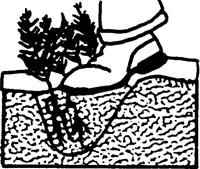
Figure 1. Heeling in.
Steps for heeling in your trees: 1) dig a U-shaped trench in a moist shady place that is deep enough to receive the full length of the roots, 2) remove seedlings from bundles and spread them out evenly, three or four trees thick, 3)fill in loose soil and water well and 4) finish filling the trench with soil and press down firmly.
Containerized Seedlings
Containerized conifer seedlings have become increasingly popular in the arid Southwest. A containerized seedling has a built-in protection system (the root plug) that reduces transplant stress during handling and planting. Containerized seedlings stored in a cool place, protected from direct sunlight and wind, usually can be held in open packages 3 to 4 weeks without a loss in planting stock quality. Keep the root plugs moist by adding enough water to each container to saturate the root plug once or twice a week. Plant as soon as possible.
When to Plant
Important environmental conditions at planting are air and soil temperature, soil moisture, relative humidity and wind speed. Extremes in any one or a combination of these conditions can cause serious seedling stress and, possibly, poor survival. This is especially true if seedlings are mishandled before planting. Plants should never be planted in dry soil. Figure 2 depicts potential damage to bareroot seedlings when roots are exposed for 5 minutes to various air temperatures in combination with wind. The extent of damage is directly related to the percent of water loss from the planting during root exposure.

Figure 2. Five-minute exposure vs. water loss in bareroot conifers.
South facing slopes should be planted first in the spring because they are the first to be free of snow and the first to dry out. North facing slopes should be planted first in the fall because they are the first to accumulate snow.
Bareroot Seedlings
Spring is the best time to plant low elevations (below 5500 feet) bareroot stock at and in mountain valleys. Summer plantings at low elevations are not recommended because of adverse environmental conditions. Summer plantings in mountain valleys are not advised because of the difficulty in coordinating planting time with the onset of summer rains. Fall plantings in mountain valleys do not provide enough establishment time before the onset of winter.
Containerized Seedlings
Spring and fall plantings with containerized stock are desirable at lower evaluation sites. Fall plantings, in particular, have resulted in excellent survival. Spring plantings with containerized stock in mountain valleys have more favorable growing environments, compared to plantings at any other time of the year. Mid-summer plantings in mountain valleys are generally acceptable if timed appropriately with the annual summer rains. However, spring plantings in mountain valleys generally yield 10 to 20% higher survival rates (depending upon the species) over mid-summer. Planting mountain valleys after August 15 is not recommended.
Planting Techniques
Many types of planting tools are available, e.g., shovel, hoedag, flat bar, plug bar, power auger or machine planter. Selection of a planting tool is based on size of planting, conditions of site and the availability of personnel, equipment and tools.
Machine planting usually gives better survival than hand methods, but is recommended only when soil conditions permit adequate machine packing of the soil around the seedling root system. Machine planting rates range from 600 to 1,000 trees an hour. Planting costs can be cut considerably on large projects.
One-man power augers are popular planting tools. Auger planting works best on loamy soil and sites that have been mechanically prepared. One auger can keep three or four people busy with a planting rate of 300 or 400 trees per day. Uniform packing of seedling roots is easier than with other hand planting methods because the soil is loosened when augered out of the hole.
Hand planting tools are easier and cheaper to use for small projects. Planting quality can also be improved with site preparation before planting. Planting rates per person range from 800 to 1,200 seedlings per day, depending on site conditions and planting experience. Planting procedures with hand took must be closely followed to ensure high survival.
The following statements are generalized handling and planting instructions for both bareroot and containerized seedlings.
Bareroot Seeding Handling
- Minimize seedling exposure to air (figure 1) or freezing temperatures.
- Use heavyweight canvas or insulated carrying bags for bareroot stock
- Minimize root damage:
– Do not count seedlings.
– Do not shake or beat seedlings.
– Do not strip or prune roots.
– Do not twist or twirl lateral roots. - Loosely stuff carrying bags.
- Cover roots with wet peat moss.
- Close partially filled shipping packages.
- Store bags in insulated trailer or shade.
- Remove only one tree at a time from planting bag.
- Plant all trees in carrying bag before break.
- Follow proper planting procedures.
- Return all unused trees to proper storage bags storage location.
Containerized Seedling Handling
- Thoroughly wet container stock 24 to 48 hours before planting.
- Minimize seedling exposure to direct sunlight; keep seedlings in shade until planted.
- Remove only one seedling at a time from its container
- Avoid freezing of root plug.
- Extracting containerized seedlings
– Squeeze the tube between fingers to loosen the root plug from the sides of the tube. Extract seedling by pulling straight up. Do not bend root plug.
– If the root plug cannot be extracted, cut 1/2 inch off the bottom of the tube and repeat step above.
– If container lacks vertical rips, sever all lateral roots encircling more than 50% of the root ball.
Bareroot and Container Planting Procedure
- Avoid planting in standing water.
- Avoid planting in rocky outcrops.
- Avoid planting in duff (decomposing forest litter).
- Planting hole should beat least 1 inch deeper than the existing root system.
- Place seedling in planting hole at the depth it grew in the nursery or slightly deeper.
- Allow roots to hang naturally without turning or twisting. Do not bend tap root in “J” or “L” shape in the planting hole.
- Close hole and pack soil firmly around seedling roots to avoid air pockets.
- Use moist mineral soil to fill hole. Do not mix soil with snow, grass, sticks or rocks.
- On poor or marginal sites, a thin layer of mulch around newly planted seedlings will reduce evaporation.
- Water trees immediately after planting if possible to help settle soil and to reduce seedling moisture stress during establishment.
See appendices A through D for an illustrative review of planting techniques.
All seedlings experience some transplant shock. Typical seedling responses to transplanting are needle dieback, failure to break bud, or death. Occasionally, some species will flush foliage on the new candle while the previous year’s needles die back. Good planting techniques reduce transplant
shock.
Most transplant shock, generally visible as browning of the needle tips and wilting, is not caused by poor planting stock or droughty conditions, but by poor root-to-soil contact created during planting when air gaps form at the root/soil surface. Seedling stress caused by air gaps can occur even under environmental conditions favoring low rates of transpiration. Recovery is only as fast as root regeneration and growth into moist soil can occur.
The degree and length of transplant shock depends on the type and duration of stress. A combination of severe site conditions, improper handling and poor planting techniques can lead to an extended disruption in normal plant biological functions and, possibly, death.
For additional information regarding seedling storage, handling and planting, contact the Mora Research Center or the nearest State Forestry District office (Appendix E).
Appendix A
Correct Method of Seedling Planting
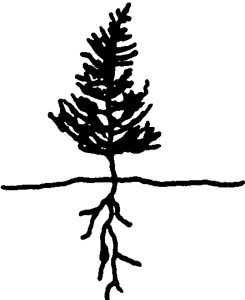
– Soil firmly packed around roots.
– No air pockets.
– Roots straight with no J or L bends.
– Root collar at or slightly below ground level.
– Root not pruned.
Error in Planting
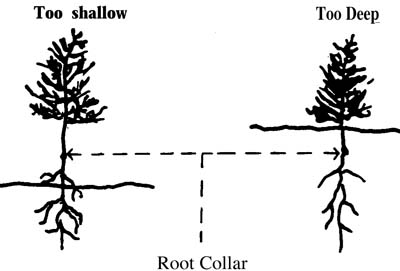
Too shallow
– Hole not deep enough.
– Root collar and upper roots exposed.
– Roots dry out.
Too deep
– Hole is too deep.
– Root collar buried.
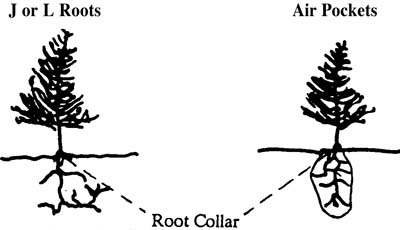
J or L Roots
– Hole is not deep enough—planting in rocky soil
– Roots cannot effectively take up water.
– Tree not wind-firm.
Air Pockets
– Soil not firmly packed around roots.
– Air pocket forms.
– Roots dry out.
Appendix B
Planting with a Flat Bar
- Insert flat bar straight down.
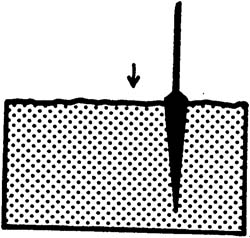
- Pull flat bar backward to open hole.

- Remove flat bar and place seedling at correct depth with root collar at or slightly below ground level.
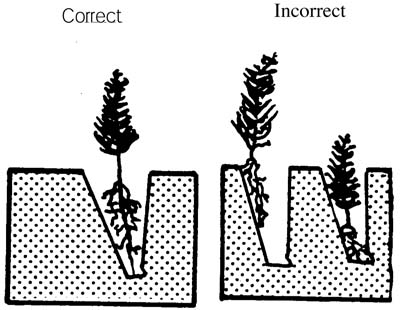
- Insert flat bar straight down until flat bar footrest is level with ground.
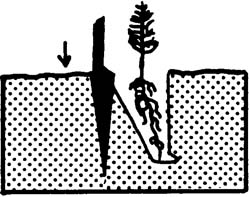
- Pull flat bar backward to pack soil around lower part of seedling to eliminate air pockets.
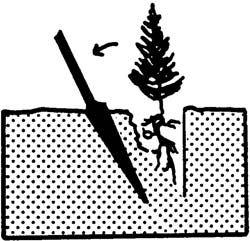
- Push flat bar forward to pack soil firmly against upper part of seedling.
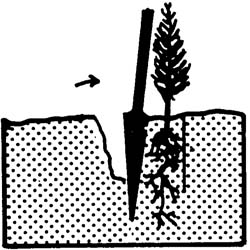
- Remove flat bar and fill in last hole by firming with heel.

Appendix C
Planting with a Hoe
- Swing hoe to get full penetration.
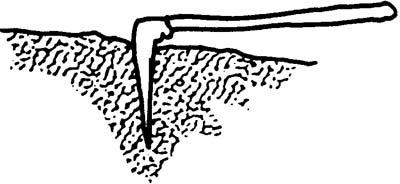
- Lift handle and pull up to widen hole.
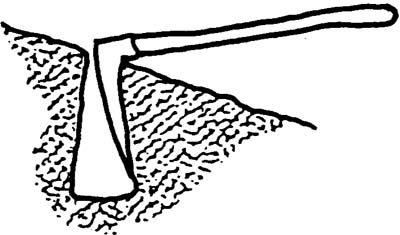
- Place seedling while using hoe to hold back soil.
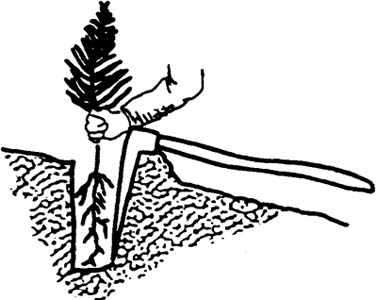
- Use hoe to pack soil at bottom of hole.
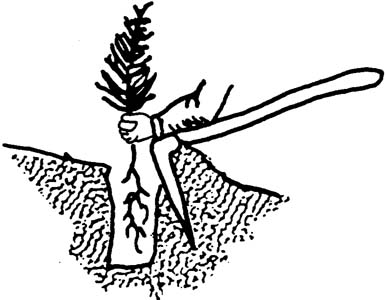
- Use hoe to pack soil at top hole.
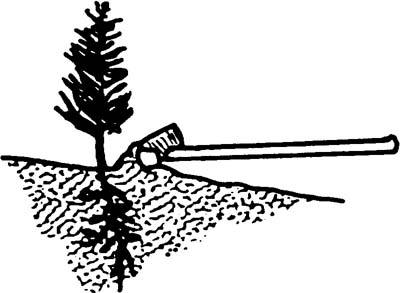
- Firm soil around seedling with feet.
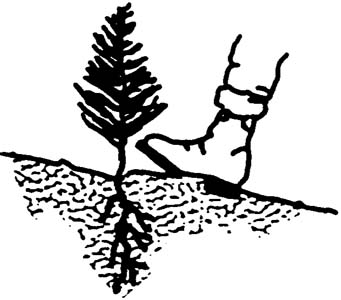
Appendix D
Punting with a Plug Bar
- Insert plug bar straight down until plug bar footrest is level with ground.
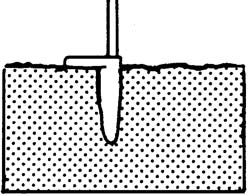
- Remove plug bar and place seedling in hole.

- Firm soil around seeding with heel of boot.
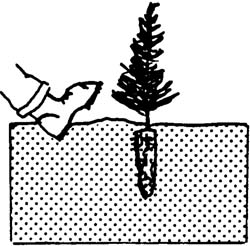
Appendix E
Mora Research Center and State Forestry Offices
Mora Research Center
New Mexico State University
P.O. Box 359
Mora, NM 87732-0359
(505) 387-2319/2317
New Mexico Division of State Forestry
P.O. Box 1948
Santa Fe, NM 87504-1948
(505) 827-5830
New Mexico Division of State Forestry
Bernalillo District Office
P.O. Box 458
Bernalillo, NM 87004
(505) 867-2334
New Mexico Division of State Forestry
Capitan District Office
P.O. Box 277
Capitan, NM 88316
(505) 354-2231
New Mexico Division of State Forestry
Chama District Office
Rt. 1, Box 100
Los Ojos, NM 87520
(505) 588-7831
New Mexico Division of State Forestry
Cimarron District Office
P.O. Box 5
Ute Park, NM 87749
(505) 376-2368
New Mexico Division of State Forestry
Las Vegas District Office
P.O. Box 441
Las Vegas, NM 87701
(505) 425-7472
New Mexico Division of State Forestry
Socorro District Office
P. O. Box 946
Socorro, NM 87801
(505) 835-5728
Chemical trade names listed in this publication are neither warranties nor recommendations and cannot be regarded as such. The user of any pesticide chemical is responsible for proper application in strict adherence with all label directions on the pesticide container and takes full responsibility for any damage or injury caused by the pesticides suggested in this publication, whether to crop, person, or property.
To find more resources for your business, home, or family, visit the College of Agricultural, Consumer and Environmental Sciences on the World Wide Web at pubs.nmsu.edu.
Contents of publications may be freely reproduced for educational purposes. All other rights reserved. For permission to use publications for other purposes, contact pubs@nmsu.edu or the authors listed on the publication.
New Mexico State University is an equal opportunity/affirmative action employer and educator. NMSU and the U.S. Department of Agriculture cooperating.
Revised October 1989, Las Cruces, NM.


